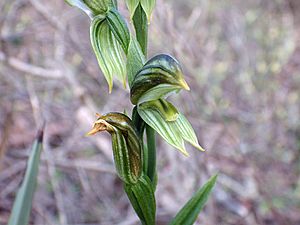Green-striped leafy greenhood facts for kids
Quick facts for kids Green-striped leafy greenhood |
|
|---|---|
 |
|
| Pterostylis chlorogramma in the northern Grampians | |
| Conservation status | |
| Scientific classification | |
| Genus: |
Pterostylis
|
| Species: |
chlorogramma
|
| Synonyms | |
|
Bunochilus chlorogrammus (D.L.Jones & M.A.Clem.) D.L.Jones & M.A.Clem. |
|
The green-striped leafy greenhood (Pterostylis chlorogramma) is a special type of orchid. It belongs to the orchid family and is found only in Victoria, Australia. This means it's endemic to that area.
When this plant flowers, it can have up to seven see-through green flowers. These flowers have cool darker green stripes. Each flower also has a green "lip" (called a labellum) with a dark stripe down its middle.
If the plant isn't flowering, it has a group of leaves shaped like a circle. This is called a rosette. These leaves grow on a short, thin stem. But when the plant is flowering, it doesn't have this rosette. Instead, it has five to seven leaves growing directly on its main stem.
Contents
What the Green-Striped Leafy Greenhood Looks Like
The green-striped leafy greenhood is a plant that grows from an underground part called a tuber. It's a perennial plant, which means it lives for more than two years. It's also deciduous, so it loses its leaves at certain times of the year.
Leaves and Stems
If the plant is not flowering, it has a rosette of three to six leaves. These leaves are shaped like a spear or a narrow egg. Each leaf is about 10 to 23 millimeters (0.4 to 0.9 inches) long. They are also about 3 to 5 millimeters (0.1 to 0.2 inches) wide. These leaves grow on a thin stalk that is 2 to 7 millimeters (0.08 to 0.3 inches) long.
When the plant is flowering, it grows a tall stem. This stem can be 200 to 450 millimeters (7.9 to 17.7 inches) high. It has five to nine long, narrow leaves on it.
Flowers and Their Parts
The flowers of the green-striped leafy greenhood are a see-through green color. They have darker green stripes. Each flower is about 15 to 18 millimeters (0.6 to 0.7 inches) long. They are also about 7 to 9 millimeters (0.3 to 0.4 inches) wide.
The top part of the flower is made of two fused parts: the top sepal and the petals. These parts join together to form a hood. This hood covers the central part of the flower, which is called the column. The top sepal has a short, pointed tip.
The two side sepals point downwards. They are about 13 to 16 millimeters (0.5 to 0.6 inches) long. They are also 6 to 7 millimeters (0.2 to 0.3 inches) wide. These sepals are joined together for part of their length. Then, they suddenly become very thin points, about 4 to 5 millimeters (0.16 to 0.20 inches) long.
The "lip" of the flower, the labellum, is about 7 millimeters (0.3 inches) long. It is about 3 millimeters (0.1 inches) wide. This labellum is a pale green color. It has a dark green stripe running down its middle. There is also a dark green bump on its top end.
This orchid usually flowers between July and September.
How it Got its Name
The green-striped leafy greenhood was first officially described in 1993. Two botanists, David Jones and Mark Clements, gave it its scientific name. They published their description in a science journal called Muelleria. The plant they studied was found near Grantville.
The scientific name for the plant is Pterostylis chlorogramma. The second part of the name, chlorogramma, is a special word called a specific epithet. This word tells us something unique about the plant. In this case, chlorogramma refers to the green stripes that you can see on its flowers.
Where it Lives
The green-striped leafy greenhood grows in certain types of forests. These forests are usually found near the coast of Victoria, Australia. You can find them in areas between Yarram and Edenhope.
Scientists are still trying to figure out exactly where all these orchids grow. Sometimes, it's hard to tell them apart from other similar types of greenhood orchids. This can make it tricky to map out their exact locations.
Protecting This Orchid
The green-striped leafy greenhood is considered a special plant that needs protection. The Australian Government lists it as "vulnerable." This means it could become endangered if we don't protect it. The Victorian Government also lists it as "threatened."
There are a few things that can harm these orchids:
- Weeds: Other plants that aren't native can grow and take over their space.
- Animals: Rabbits and large hopping animals like kangaroos can eat the plants.
- People: People walking or riding trail bikes can accidentally step on them. Road maintenance work can also disturb their habitat.
It's important to protect these special orchids so they can continue to grow in Victoria.


